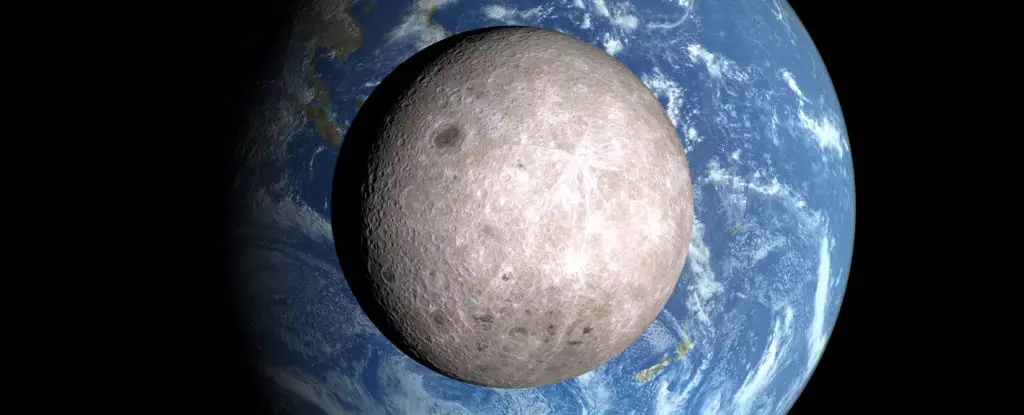The Moon, Earth’s celestial companion, continues to captivate scientists with its diverse surface features and geological history. A recent analysis has revealed a surprising asymmetry in water distribution between the Moon’s two hemispheres. This finding accentuates the distinct geological and chemical makeup of the near side, which faces Earth, compared to the heavily cratered far side, which perpetually eludes our view. Notably, the near side harbors vast basaltic plains, known as “maria,” formed by ancient volcanic activity, while the far side appears starkly different, presenting a mystery that begs further exploration.
The contrasting features of the Moon’s two hemispheres suggest a more complex geological narrative than previously understood. Studies indicate a heterogeneous distribution of water, with the near side displaying an impressive range of 1 to 200 micrograms of water per gram of rock. In stark contrast, the far side presents a puzzling picture of relative dryness, raising questions about its formation and evolution in relation to the Earth. This perceived imbalance offers tantalizing clues into the broader story of our planetary neighbor’s past, especially in relation to the theories surrounding its formation.
The Giant Impact Hypothesis: A Blueprint for Lunar Formation
Current leading theories about the Moon’s formation revolve around the catastrophic impact hypothesis, proposing that a Mars-sized body, dubbed Theia, collided with the early Earth. This cataclysmic event released vast amounts of debris, which eventually coalesced to form the Moon. The ramifications of this collision may not only explain the Moon’s current phase but also its internal characteristics, including the peculiar distribution of water. The idea posits that the energy from such a colossal impact would have altered the Moon’s chemical make-up, including the retention and distribution of water within its mantle.
As scientists labor to unravel the enigma of this cosmic collision, the exploration of lunar samples has become pivotal. Each collected sample contributes to a growing understanding of the Moon’s uneven thermal history and geological evolution. This question of water distribution—so critical in establishing the Moon’s past volcanic activity—may provide significant insights into the Moon’s compositional evolution post-formation. The findings, especially those derived from the Chang’e-6 lunar mission, may not only reshape our understanding of the Moon but also enhance our comprehension of planetary formation in the solar system.
Challenges in Understanding the Lunar Water Mystery
The Chang’e-6 mission stands as a significant milestone in lunar research, providing precious samples from the Moon’s far side that were previously unattainable. This remarkable mission has enabled scientists to engage in in-depth analysis of the lunar surface’s chemical composition. By examining minerals such as olivine and ilmenite, researchers discovered that the basalt contributing to the far side’s South Pole-Aitken Basin has a surprisingly low water content, estimated at just 1 to 1.5 micrograms per gram.
Such findings evoke further intrigue, suggesting that the water scarcity on the far side might not solely be a result of the lunar impact event. There’s a possibility that geological processes or the dynamics of material displacement during the impact may have caused some of the water to migrate to the near side. However, this remains speculative; future missions and additional sample collections will be imperative to verify hypotheses regarding this planetary dichotomy.
The Implications for Planetary Science Beyond Our Moon
The implications of this research extend beyond the Moon, as understanding the water distribution on our nearest celestial neighbor can inform scientists about the formation processes of other planetary bodies in our solar system. The Moon serves as an analog for understanding how tectonic activity and environmental conditions impact water retention and distribution in terrestrial bodies both large and small.
Moreover, as exploration of other celestial bodies intensifies—most notably Mars and the moons of Jupiter and Saturn—researchers can draw parallels from the Moon’s unique water composition. Insights gleaned from lunar geology can assist in deciphering the histories of these distant worlds, further illuminating the conditions necessary for sustaining water and possibly life beyond Earth.
The ongoing quest to study the Moon thus acts as a precursor for humanity’s broader exploration of the cosmos. Each data set gathered offers a glimpse into the mechanics not only of the Moon’s evolution but also of potential extraterrestrial environments, steering the helm of planetary science into new realms of discovery. Continued investigation of the Moon’s dynamic past is not just a scientific endeavor; it paints a narrative of our own planet’s history, revealing the intricate dance of celestial bodies within our solar system.


Leave a Reply